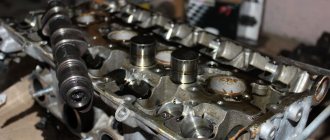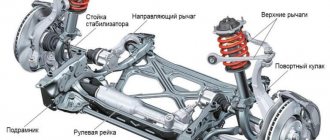Car service specialists, as well as car manufacturers, recommend changing the oil in gasoline or diesel engines every 10 thousand kilometers. But even if you follow these regulations, sooner or later the car owner notices that an emulsion has formed on the oil filler cap. In appearance, this emulsion resembles mayonnaise and plunges many drivers, and especially beginners, into shock. By the way, the color of “mayonnaise” may vary. Let's look at the reasons for this phenomenon, and also find out how to deal with the problem.
What is white emulsion?
Modern motor oils, which are sold everywhere today, are made on a hydrocarbon basis. When gasoline burns, various substances are formed. These are antifreeze, water, alcohols, acids, and peroxides. All these substances in the hydrocarbons mix, resulting in the formation of a white emulsion on the oil filler cap. Why does she appear here? It's simple - due to the huge number of microscopic bubbles, the emulsion has a white color in case of severe contamination of the oil. The filler cap and dipstick are one of the coldest places.
Therefore, “mayonnaise” sticks well to these surfaces.
Causes
Car service specialists and simply experienced car enthusiasts say that there are a huge number of reasons for the appearance of emulsion. Most often, this white mixture can occur when coolant enters the crankcase of the power unit. This can happen due to a breakdown of the gasket between the cylinder head and the engine block. Also, the emulsion on the oil filler cap may indicate cracks in the cylinder block or head. Another possible reason for antifreeze getting into the crankcase is deformation of the cylinder head elements. Condensation is still possible, especially in winter.
Also, “mayonnaise” is formed when there is no ventilation of crankcase gases in the engine. The gas is hot and contains a large amount of water, which is deposited in the form of condensation in the upper part of the motor. As a result, a white emulsion accumulates on the oil filler cap. It is quite difficult to figure out the exact reason why this “mayonnaise” that frightens many car enthusiasts occurs. But in most cases this is due to a breakdown of the cylinder head gasket. Because of this, the coolant easily enters the oil channels and mixes with the oil there. It should be noted that if antifreeze gets into the lubricant, it can no longer be used. Both the oil and coolant need to be changed. This is true for all car models without exception. An emulsion appears on the oil filler cap on all machines without exception if there is damage or operating conditions are violated. Car enthusiasts often encounter “mayonnaises” of different colors at the first drop in temperature – in autumn and winter. But there is no need to sound the alarm. This is condensation that occurs due to the temperature difference between a warm engine and the air outside. When the engine warms up, then the moisture in the oil will evaporate, but some of it will accumulate in the form of condensation on the neck plug. What’s interesting: many cars are susceptible to this disease, but the Gazelle practically does not suffer from it.
What to wash with?
If it turns out that the emulsion was formed due to antifreeze getting into the oil, then it is worth flushing the engine. Today, special means are used for these purposes. These include waste additives and flushing oils.
When choosing a product, the driver must proceed from the purpose of flushing. For example, if he needs to carry out a procedure before changing the oil, then a regular five-minute liquid will do. But in a situation with an emulsion, it alone cannot do it.
Flushing oils are excellent for flushing out the white emulsion from the internal combustion engine. But the risk of clogging channels and filters with dissolved dirt still exists. You need to work with the substance carefully.
There is a popular method that helps to wash without risking other parts of the car. To do this, you need to mix mineral oil and diesel fuel in a 3:1 ratio. The resulting mixture is used to perform several washing cycles at idle speed. By the way, it is enough to carry out one cycle with flushing oil. After this, you can fill in new oil.
Possible consequences
When water, condensate or coolant gets into lubricating products, the oil quickly loses its properties. Accordingly, lubricating properties are reduced. In winter, oils can even crystallize, which will not have the best effect on engine performance. The film between rubbing pairs of parts leads to rapid wear of all parts in the engine without exception.
Most often in these cases the engine simply jams, and this is an expensive repair. Therefore, if an emulsion has formed on the oil filler cap, the reasons should be carefully examined. It is urgent to find the problem and fix it.
Chemical incompatibility
It is necessary to add the same engine oil as was added during replacement. Mineral oil is in no way compatible with synthetic oil. This “mix” disrupts the structure of the liquid. This is due to the fact that in mineral oil the hydrocarbon molecules have a wide range in size, while in synthetic oil all the molecules are homogeneous.
Due to the different molecular sizes of mineral oil, it performs well under operating temperature changes. Thus, the viscosity, freezing temperature and level of lubrication of the rubbing elements by the liquid change.
As you know, oil is not completely homogeneous. It contains various additives. They vary depending on which area needs more lubricity to be added. It happens that the added additive begins to enter into a chemical reaction with the poured oil, which leads to the appearance of foam.
More about condensate
Even those who store their cars in a garage face this problem. But most often it bothers those who park their cars in the yard. If a car regularly spends the night outside in the fall during the rainy season, then a large amount of water vapor may well enter the crankcase cavity. They condense in pipes and on oily surfaces. At one time, 1-2 g of condensate can enter the motor. This is quite enough to form an emulsion on the oil filler cap. By the way, bubbles will also be visible on the dipstick. In winter, the owner will see “mayonnaise” very often. If the car is constantly driven short distances and the engine does not warm up to 90 degrees, then this is also one of the reasons why condensation accumulates in the engine. “Treatment” is carried out by long runs, or warming up to operating temperatures.
It is necessary to highlight the main reasons due to which oil can foam
The cylinder block is equipped not only with a lubrication system, but also with a cooling system. For this purpose, the designers made special channels in the block. The main coolant is antifreeze, which absorbs the heat coming from the cylinders and thereby cools the engine. The entire cooling system, like the lubrication system, is well sealed. A pump, the so-called pump, moves the coolant through the pipes.
It happens that the gasket between the cylinder head and the block itself has worn out and a crack has appeared on it. In this case, antifreeze will be able to get into the lubrication system, which will inevitably lead to the oil starting to foam.
The second reason why the liquid foams is the incompatibility of the oils being poured. During replacement, there is no way to remove the old fluid without leaving any residue. As a result, a mismatch of chemical parameters may occur, which will lead to the formation of bubbles.
Faulty crankcase ventilation system
If the ventilation system is clogged and does not work as it should, then gases and vapors will try to escape through the dipstick and other places in the internal combustion engine. In this case, it is not surprising that an emulsion appeared on the oil filler cap.
The only good thing is that the oil is clean and there is no antifreeze in it. If you fix the crankcase ventilation system, then you won’t even have to replace lubricants.
Diagnostics
To check these reasons, the lubricating fluid is drained from a sufficiently warm engine into a prepared container. In hot oil, traces of coolant will be visible even to the naked eye, which will turn into an emulsion as it cools. If there is a lot of water in the antifreeze, then most of it will accumulate under a layer at the bottom of the crankcase. Naturally, this liquid will be sucked up by the oil receiver. If a yellow emulsion has formed on the oil filler cap, then it is better to temporarily stop using the car. The viscous mixture will clog the channels for the movement of lubricant. Connecting rod bearings, piston rings, and main bearings with such liquid will quickly fail.
Why do you need to get rid of foaming?
The oil in which foam has already formed must be removed urgently. It cannot fully perform the functions assigned to it. In this case, the oil loses its homogeneity. The oil and the resulting bubbles have different densities. Because of this, heat will not be able to be removed quickly, which will inevitably lead to overheating of the motor.
It must be said that foamed oil does not pass well along the cylinder walls. Thus, the pump pumps oil poorly, and as a result, pressure is lost. The viscosity of the liquid deteriorates.
When oil combines with water, virtually no lubrication occurs. In addition to the fact that the motor will overheat, the friction of the elements will increase, which will lead to scuffing, as well as too rapid wear of the rubbing components. As a result, they will simply fail. It must be remembered that condensation is water, and water freezes at 0 degrees. This means that in winter, during frosts, the oil can simply freeze, blocking the supply of still good oil. Subsequently, a water hammer may occur, which will lead to a major overhaul of the internal combustion engine.
As a conclusion, we can say that you need to constantly monitor the condition and amount of oil in the engine. If it so happens that a similar situation arises, then it is necessary to urgently carry out repair work to eliminate problems.
Cylinder head gasket failure
If emulsion is visible on the oil filler cap, the reasons are often a leaky gasket. A breakdown is possible due to burnout due to overheating or as a result of physical obsolescence and wear of the gasket. But such cases occur only on old engines that have not been monitored. The main sign of a breakdown is unstable operation of the motor. The coolant leaving the expansion tank will also be noticeable. If you carry out diagnostics in a timely manner, then you can limit yourself to only replacing the gasket. This is done in literally two hours. If you let go of the situation, then everything will be much worse.
How to determine the malfunction yourself
In the process of superficial diagnostics, you should start by checking the level of antifreeze or antifreeze in the cooling system. To do this, you need to unscrew the cap of the expansion tank on a slightly cooled or cold unit. A decrease in coolant level without obvious reasons may indicate a malfunction in the cylinder head area, problems with the cylinder head gasket or the cylinder block itself.
- Broken or defective gaskets are the most common cause of moisture getting into the oil. In other words, the oil contains coolant, which is a mixture of chemical concentrate and water.
The seal of the gasket is usually broken both as a result of natural wear and tear of this element, and after overheating of the motor. If overheating previously occurred and the gasket was not changed, then the condition of the oil must be monitored separately.
Natural wear of the gasket occurs due to the fact that the element experiences significant temperature loads and constantly operates under conditions of high pressure. As a rule, the gasket fails at mileage of 100 thousand km. and more. With a broken gasket, the engine runs unevenly and antifreeze leaves the cooling system.
To eliminate a malfunction that occurred after natural wear, you simply need to remove the cylinder head and replace the gasket. If the engine overheats, then grinding the cylinder head may be required.
- After overheating, the engine cylinder head often “leads”. This means that the geometry is violated, the mating planes of the BC and cylinder head do not coincide, and it is not possible to achieve a normal fit even after replacing the gasket. In such a situation, the engine requires more serious repairs or even replacement of the cylinder head.
If there are problems with the gasket, exhaust gases can enter the cooling system, as a result of which, after unscrewing the radiator cap or expansion tank, you can see smoke and bubbling of the coolant of varying degrees of intensity.
- The appearance of cracks in the cylinder block or cylinder head can also occur as a result of overheating or temperature changes, or be the consequences of wear, damage or freezing of the coolant in the cooling system.
In the latter case, a common cause is the use of running or distilled water instead of antifreeze, pouring low-quality coolant, a large amount of water in relation to the concentrate, or an antifreeze or antifreeze concentrate that was incorrectly diluted with water.
- The possibility of active accumulation of condensate in the internal cavity of the engine crankcase should not be excluded. This occurs when weather or other conditions cause significant temperature changes. During such changes, outside air enters the engine crankcase through the breather and crankcase ventilation system.
Cracks in the cylinder head and block
An emulsion on the oil filler cap (including VAZ-2107) is often formed due to cracks in the head or block. This happens due to freezing of antifreeze. It is necessary to monitor the characteristics of the coolant operating temperatures. Do not pour water into the radiator.
It remains inside the system even if the coolant is completely drained. As a result, water freezes in the most inappropriate places. Most often, the channels of the block or cylinder head crack. Also, engines are deformed due to mechanical shocks. If there was a frontal impact on the car, you should not exclude the possibility of cracks appearing on the block.
Features of VAZ cylinder heads
The cylinder heads of engines installed on VAZ modifications 2101, 2102, 2103, 2104, 2105, 2106, 2107 have special aluminum plugs. These plugs block the access of coolant to the cylinder head. Sometimes (especially in very old cars) these plugs can break down and leak, allowing coolant to leak into the oil. For this reason, owners of the modifications listed above should take this defect into account, since it is not typical for most car models.
Conclusion
Perhaps the most reliable way to protect your engine from problems with the emulsion is attentiveness. Signs indicating the formation of a dangerous concentration of emulsion in the engine are not so difficult to notice and detect. And when identifying them, you just need to follow simple rules and recommendations. This approach will avoid high repair costs and save your time.
Video about emulsion in the engine:
Water in the engine sump
This problem can only be eliminated by completely replacing the lubricant. It is best to flush the engine using specialized substances. An emulsion often forms on the oil filler cap in winter due to temperature changes.
The situation when water enters the crankcase through the combustion chambers is very rare in itself. This is only possible on engines where the piston group is in poor condition with “tired” rings.











